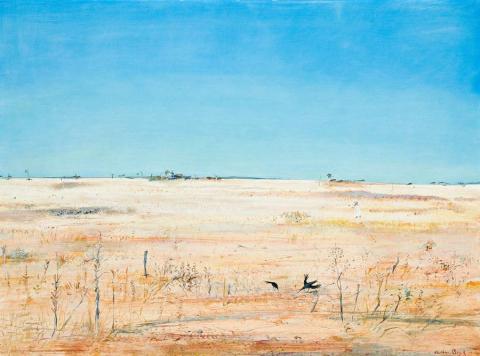WIMMERA LANDSCAPE
Arthur Boyd
oil and tempera on composition board
91.0 x 122.0 cm
signed lower right: Arthur Boyd
Savill Galleries, Sydney
Private collection, Sydney
Arthur Boyd's landscapes span his entire creative oeuvre, providing some of the most perceptive insights into the Australian scene and its idiosyncrasies. From the 1930s, the thickly textured landscapes of Rosebud led into those lyrical transcripts of Harkaway and Berwick, which are considered to be among the treasures of Australian art. Then, in the summer of 1948-49, Boyd made his first trip to the Wimmera, painting the dry wheat plains of north-western Victoria. His eye was also attracted by The Grampians, the old mining country around Bendigo, and Central Australia, the memorable The Waterhole with Birds, near Alice Springs, c.1954, being purchased by the National Gallery of Victoria soon after it was painted. There are also the equally memorable Gaffney's Creek paintings, which Boyd completed before he moved to London and international fame. Even on the other side of the world, the landscape continued to have its appeal, and in Suffolk Copse, 1977, Boyd reversed the order of things by giving this English view an Australian flavour. In 1971, in Canberra on a Creative Art Fellowship from the Australian National University, he visited Bundanon, and began his love affair with the Shoalhaven River and its noble landscape. Although Boyd is rightly highly regarded for his subject paintings of the Bride, the Nebuchadnezzar series, mythological paintings and the like, it is worth recalling that it was a landscape that Boyd was commissioned to do for the tapestry that now hangs so grandly in Canberra's Parliament House.
Wimmera Landscape belongs to the later 'Wimmera' subjects painted in the early 1960s in which he continued to use tempera as a favoured medium. As in the earlier Irrigation Lake, Wimmera, c.1950, also in the National Gallery of Victoria, tempera combines a subtle, opalescent glow with immaculate surfaces. It provides the perfect foil for the scruffy landscape of skeletal trees, bushes and grasses that untidily sport across its surface, peopled only by black crows and a lone figure in the middle distance. The endless blue sky adds to the feeling of openness, of land and heavens divided by an horizon that seems to stretch forever in a land that celebrates its own barren dryness.
DAVID THOMAS
